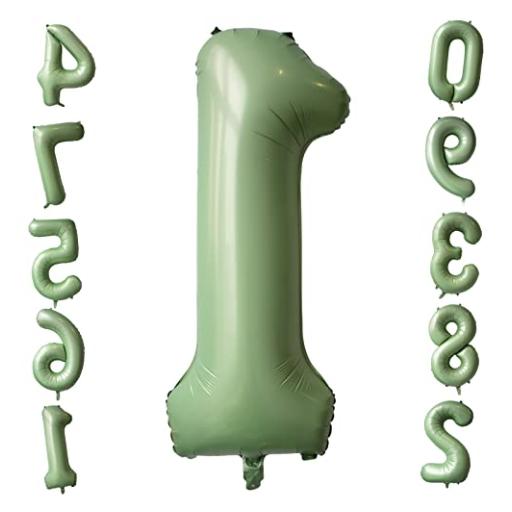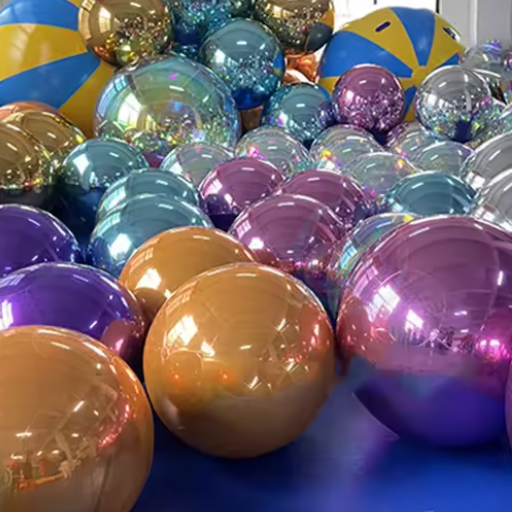Helium foil balloons are usually at the center of celebrations, and with their vibrant colors and joy, they are often offered at birthdays, weddings, and other parties. But do you ever stop to wonder how long these festive decorations last once filled with air? Knowing how long a helium foil balloon stays inflated can help you schedule your event more effectively, ensuring your decorations remain picture-perfect when it matters most. This article will delve into the science behind float time, as well as the methods to extend the life of your balloons, ensuring they remain airborne for as long as possible.
Understanding Helium Balloons

Helium balloons float because they are filled with helium, a gas that is lighter than the surrounding air. The lifespan of a helium foil balloon can range from 3 to 5 days; however, a well-sealed balloon may last up to a week, and possibly even longer. Factors that can affect the time it takes for the balloon to stay inflated include the room temperature, humidity, and the amount of sunlight it receives. Of course, to be punctual in retaining any kind of time for floating, helium balloons should always stay cool, far from anything sharp, and must not be exposed to sudden temperature changes.
What Are Helium Foil Balloons?
Helium foil balloons are durable, metallic-coated ones filled with helium gas, designed for use as decorations at celebrations. They are popular due to their significantly longer float compared to those of the latex ones.
How Helium Balloons Float
Helium balloons float because of the unique properties of helium gas. It is a very light gas with an atomic weight less than that of air. The basis of balloon buoyancy is Archimedes’ principle, which states that an object is buoyed upwards by a force equal to the weight of the fluid displaced. When helium is injected into a balloon, the balloon weighs less than the weight of the air displaced, thereby allowing it to float.
Helium has an atomic mass of 4, and it is significantly lighter than the nitrogen and oxygen molecules, which constitute a substantial part of air, with average molecular masses of approximately 28 and 32, respectively. This considerable difference in density causes helium balloons to rise spontaneously through the air.
Additionally, we can calculate the amount of lift a typical helium balloon provides. One cubic foot of helium can lift an object that weighs 1.02 ounces. A small object weighing about 1 lb could be lifted by 16 standard helium balloons, each with a 1-foot diameter.
Temperature and pressure in the atmosphere can affect how high helium balloons can float. Suppose the atmospheric pressure decreases or the temperature drops with increasing altitude. In that case, the helium will expand, making the balloon less dense and increasing the likelihood of it bursting if it is too high. Hence, there is a constraint on the maximum altitude of helium balloons.
Understanding these scientific aspects clarifies the ability of helium balloons to float and provides insight into how they behave under varying environmental conditions.
Comparing Mylar and Latex Balloons
|
Parameter |
Mylar Balloons |
Latex Balloons |
|---|---|---|
|
Material |
Metallic polyester film |
Natural rubber latex |
|
Biodegradability |
Non-biodegradable |
Biodegradable |
|
Cost |
Higher per unit |
Lower per unit |
|
Customization |
Complex designs, logos, shapes |
Simple designs, logos, colors |
|
Float Time |
Weeks to months |
12-24 hours (longer with treatment) |
|
Durability |
Airtight, less prone to leakage |
Porous, prone to helium loss |
|
Environmental Impact |
Higher due to synthetic material |
Lower, eco-friendly |
|
Best Use Cases |
Formal events, long-lasting displays |
Casual events, budget-friendly decorations |
|
Storage |
Requires careful handling |
Compact and easy to store |
|
Allergy Concerns |
Hypoallergenic |
May cause latex allergies |
How Long Do Helium Balloons Last?

The lifespan of helium balloons is determined by the type of material used on them. Latex helium balloons, with a somewhat porous structure, typically last 8 to 12 hours before deflating as helium escapes. With a less porous structure, Mylar foil balloons can float for 3 to 5 days or more. Another factor affecting the helium retention time of balloons is environmental matters, especially temperature and humidity.
Average Lifespan of Helium Foil Balloons
Helium (Mylar) foil balloons generally last anywhere from 3 to 7 days, with some even lasting up to 2 weeks, provided they are kept in excellent conditions.
Factors Affecting Helium Balloon Float Time
Many factors govern the float time of helium balloons. Here are five main factors:
- Balloon Material
Latex balloons are porous and thus allow helium to escape slowly; this usually gives them a time limit of 12 to 24 hours for floating. Mylar or foil-type balloons, by way of being less porous in structure, are generally able to hold helium for anywhere between 3 and 7 days and more.
- Temperature
High temperatures cause helium to expand, and thus, balloons may burst. Low temperatures cause helium to contract, resulting in less lift and making the balloons appear deflated.
- Humidity
Different humidity levels will weaken latex balloons and cause helium to escape quickly. Mylar balloons are less affected by humidity but may lose float time if pushed to the extreme.
- Seal Quality
The better the seal, the more helium a balloon holds, and the longer it stays afloat. Lower-quality knots or seals cause helium to leak out more quickly, resulting in significantly shorter float times.
- Helium Purity
The higher the purity of the helium, the more the balloons stay afloat, and the lower the purity, i.e., when helium is mixed with air or any other gases, the ability of buoyancy required for good float time may decrease.
How Much Helium Is Needed?
Depending on the size and type of balloon, a specific amount of helium is required for inflation. Standard latex balloons, typically between 9 and 12 inches in diameter, require approximately 0.5 cubic feet of helium to be fully inflated and float properly. Even bigger balloons, such as the 18-inch foil balloons, need 0.8 cubic feet of helium, while giant (usually 36 inches in diameter) ones require 15 cubic feet of helium.
Recent times estimate helium usage by balloon size as follows:
- 9-inch latex balloon: 0.27 cubic feet of helium (float 8-10 hours)
- 12-inch latex balloon: 0.50 cubic feet of helium (float 12-16 hours)
- 18-inch foil balloon: 0.84 cubic feet of helium (float 5-7 days)
- 36-inch latex balloon: 14.1 cubic feet of helium (float 2-3 days)
Therefore, count the helium, as well as the number and size of the balloons, to determine the total amount of helium when organizing an event with helium balloons. For example, if you inflate 50 standard 12-inch latex balloons, you would need about 25 cubic feet of helium. Consider the conservation of helium, which means using high-quality balloons so they float for as long as possible, thereby saving unnecessary helium waste in little to no time.
Extending the Life of Helium Balloons

Many techniques can prolong the float time of helium balloons. In general, a 12-inch latex balloon filled with helium floats for about 8-12 hours, whereas foil (Mylar) balloons typically last from three to five days and sometimes even longer. With proper care, this time can be lengthened.”
- Use Hi-Float Solution
This is a commonly recommended procedure for extending float time by applying Hi-Float inside latex balloons. This liquid solution forms a coating that serves as a barrier to slow down helium leakage through the porous latex material. When used as recommended, Hi-Float can make balloons float up to nearly 25 times longer; thus, they can remain afloat for several days.
- Use Foil Balloons
Foil balloons are much less porous than latex balloons and may retain helium for at least 7-10 days, if not weeks, depending on how they are handled. Since foil balloons can be reused, they present a cheap and environmentally friendly option.
- Avoid Heat and Sunlight Exposure
Helium expands with heat, so balloons would either pop or deflate faster. Hence, keep the balloons in cooler conditions, away from direct sunlight or any hot surface. Storage in room temperature would be ideal for maintaining helium longer.
- Properly Seal Balloons
Balloons should be tied and sealed correctly. Direct sealing may otherwise diminish the time to produce a float. Cheap clips will do the job, but professional sealing of balloons will enhance the float time.
- Inflate Balloons on the Day of the Event Usage
To ensure the balloons appear fresh and vibrant during your event, inflate them as close to the start time as possible. If you want decorations to stay up throughout the day and for several days, choose a mix of foil and Hi-Float-treated latex balloons.
- Humidity considerations
A high moisture content can degrade balloon envelopes and accelerate helium loss. If your event is situated in a humid area, ensure that you carefully store balloons properly in dry conditions before use.
Data on Float Time Extensions
According to recent facts:
- Standard 12-in. latex balloons float on helium for 8-12 hours; with Hi-Float treatment, the duration extends up to 2-3 days.
- The larger latex balloons, such as 24-inch ones, can float for 3-5 days when treated with helium and Hi-Float.
- Helium-filled foil (mylar) balloons retain their buoyancy for at least 7-10 days, and some can last for weeks under varying environmental situations.
Make wise choices about balloon types, environment, and treatment methods; helium balloons will surely make for a gorgeous and long-lasting decoration for your program.
Tips to Make Balloons Stay Inflated Longer
- One must choose high-quality balloons, whether in premium latex or foil, as they may leak air if lower-quality materials are selected. Therefore, quality materials afford much time for inflation.
- Applying Hi-Float: In the case of latex balloons, a sealant like Hi-Float is used inside the balloon to prevent helium leakage, thereby increasing float time up to 25 times the normal duration of a balloon.
- Do Not Over-Inflate: Over-pressure may stretch the material too much and become vulnerable to bursting or deflating at a very rapid rate. Inflate balloons to the recommended sizes for optimal durability.
- Keep Balloons in Cooler Temperatures: Heating is said to cause a tendency for helium to expand rapidly and escape, whereas cold temperatures may cause the balloon to contract. To extend their shelf life, balloons must be stored and displayed in a stable environment with consistent temperature.
- Anchor Balloons Well: Prevent rubbing on rough surfaces by keeping balloons in place with an appropriate weight. Movement and friction would damage the surface, causing it to finish faster in deflation.
Using Balloon Treatments
I always insist on using a high-grade balloon sealant inside each balloon to minimize helium leakage and extend its float time when it is a balloon treatment. Using my hands, I rub the sealant all over the balloon after it has been inflated. This tiny detail enables my balloons to float longer and remain vibrant for a more extended period.
Proper Storage Techniques
Proper storage of the balloons is crucial to preserve their quality and ensure they last as long as needed. The following are five essential techniques for the practical storage of balloons:
- Store in a Cool, Dry Place
Balloons should be stored in a cool, dry place, away from direct sunlight and extreme temperatures. Heat weakens the balloon material, while moisture causes it to lose its integrity.
- Avoid Sharp Objects and Surfaces
Take precautions to store balloons in a container with no sharp edges or in a location with no rough or abrasive surfaces. One simple, careless move is all it takes to puncture and tear them.
- Airtight Containers
Unused balloons should be stored in airtight containers away from air and moisture. This will retain elasticity and prevent it from drying out and stiffening.
- Keep Quiet Apart
Separate latex and foil balloons, since the materials may react differently under environmental conditions. In this way, damage can be prevented, and each type remains in top condition.
- Rotate Stocks
When storing balloons for extended periods, always ensure that the older stock is replaced first. Doing this prevents balloons from being stored for too long, which can cause them to degrade.
If all these methods are observed, you can also minimize balloon quality degradation and wastage.
Common Questions About Helium Balloons

|
Question |
Answer |
|---|---|
|
How long do helium balloons float? |
Latex: 12-24 hours; Foil: 2-5 days or longer. |
|
How to extend float time? |
Use Hi-Float for latex balloons to last 2-5 days. |
|
Can helium balloons be reused? |
Foil balloons can be reused with care. |
|
What affects float time? |
Temperature, helium quality, and balloon material. |
|
Are helium balloons safe? |
Avoid inhaling helium; supervise children with balloons. |
|
How much helium is needed? |
Depends on balloon size; e.g., 36″ needs 15 cubic feet. |
|
Can all balloons use helium? |
No, mini and some decorative balloons are air-fill only. |
|
What happens in extreme temperatures? |
Heat expands helium; cold shrinks it, affecting float. |
|
How to dispose of balloons? |
Deflate and bin responsibly; never release into the environment. |
|
Are helium balloons eco-friendly? |
Latex is biodegradable; foil is not. |
How Long Do Helium Balloons Float?
The float time of helium balloons can vary depending on the type and size of the balloon, weather conditions, and any special treatments applied. A rough estimation is:
- Latex Balloons: A helium-filled 9-12 inch latex balloon floats anywhere between 8 and 12 hours. Using a float enhancer, like Hi-Float, may grant float time from 2 to 5 days.
- Foil (Mylar) Balloons: Since Helium is slightly denser than air, so are the foil balloons; hence, they usually float longer, for about 3 to 7 days. Some, if lucky, will last up to 2 weeks in ideal conditions.
Sunshine and warmth are effective agents for reducing hemorrhaging during float time. Cold air contracts helium, reducing its buoyancy; hot air relaxes helium, encouraging it to leak. Doing the right things with these balloons will ensure a longer float time.
Do Foil Balloons Last Longer than Latex?
There are trends for foil balloons–they generally last longer than latex balloons because of differences in material composition and construction. Unlike latex, foil balloons are made of a non-porous metallic substance that holds helium more effectively. The following procedure elucidates why foil balloons outlast latex balloons:
- Material Porosity
Latex balloons are porous due to the material used to make them, natural rubber. Small helium atoms escape through the pores so the balloons do not float too long. The mylar or plastic coated with a metallic foil used for foil balloons is essentially non-porous, and such balloons retain helium far longer.
- Float Time
Latex balloons filled with helium float on average about 8 to 12 hours unless coated with a sealing solution such as Hi-Float. Foil balloons float for a minimum of 3 days up to 7 days, and sometimes even more, for about 2 weeks, depending on the conditions at hand.
- Durability
Latex balloons surely pop: the more elastic they are, the more they are bound to burst randomly under the slightest environmental influence. Foil balloons slightly resist puncturing, thus assuring longevity.
- Air Retention
Due to self-sealing valves, foil balloons retain air well, thereby making helium leakage practically insignificant. Latex balloons must have their necks tied manually, and oftentimes, a perfect seal is not achieved, hence the faster loss of helium.
- Reusability
Foil balloons can often be deflated and reused, further extending their practicality. Latex balloons are typically one-time use because they lose their shape once deflated.
All in all, these points highlight the reasons why foil balloons are ideal for long celebrations or instances that require a prolonged decoration period.
What To Do When Balloons Start to Deflate?
Whenever a balloon starts to deflate, I check if it can be refilled. With foil balloons, one uses a hand pump or a straw to add more air or helium gently. If it is latex, I opt for replacement, as they are not meant to be refilled and will hardly retain their shape. For decorations, I try to employ partially deflated balloons in balloon garlands or table arrangements to maximize their use.
References
-
Caltech’s Cool Cosmos: This site provides scientific insights into helium balloons and their behavior in the atmosphere. Visit the source1.
-
ScienceLine at UCSB: This academic resource discusses the behavior of helium-filled balloons, including their deflation process. Visit the source2.
-
University of Michigan – Safer Disposal of Balloons: This site offers information on the environmental impact and proper disposal of balloons, which can be relevant for understanding their longevity and usage. Visit the source3.
Frequently Asked Questions (FAQ)
How long do helium balloons last?
Helium balloons typically last anywhere from 8 to 12 hours when filled with helium. Factors such as the size of the balloon, the type of material, and the environmental conditions can influence their longevity. Foil balloons tend to last longer than latex balloons, often remaining inflated for several days.
How long do helium-filled balloons float?
The float time of helium-filled balloons can vary. Larger balloons generally float longer than smaller ones because they can hold more helium. Foil balloons, made of Mylar, can also extend the float time significantly compared to latex helium balloons.
How does the material of the balloon impact how long helium balloons last?
The material of the balloon plays a crucial role in determining how long helium balloons last. Foil balloons are less porous than latex balloons, which means they are better at keeping helium from escaping. This results in longer float times for foil balloons compared to latex balloons.
How can I extend the float time of my helium balloons?
To extend the float time of your helium balloons, consider using a product designed to seal the balloon and reduce helium leaks. Additionally, keeping balloons indoors and at a stable temperature can help maintain their inflation longer. Avoid exposing them to direct sunlight or extreme temperatures.
Do confetti balloons float longer than regular balloons?
Confetti balloons can have a similar float time to regular helium balloons, depending on the material used. If they are made of foil, they may float longer than latex confetti balloons. The added weight of the confetti can slightly impact their ability to stay afloat, but overall, they can still maintain a good float time.
How long does helium last inside a latex balloon?
Helium begins to seep out of latex balloons relatively quickly, usually within 6 to 8 hours. This is due to the smaller size of helium atoms compared to the material of latex, allowing the gas to escape more easily. Therefore, latex balloons tend to have a shorter lifespan than foil balloons.
What factors influence how long helium balloons stay inflated?
Several factors can influence how long helium balloons stay inflated. The size of the balloon, the type of material, the temperature, and the humidity levels are all critical. Larger balloons can hold more helium, while foil materials are better at preventing helium from escaping.
How much helium is needed to fill my balloons?
The amount of helium needed to fill your balloons depends on their size. Larger balloons will require more helium to achieve proper inflation and float. It’s essential to ensure that the balloon is adequately filled but not overinflated to prevent it from popping.
Why do helium balloons deflate faster outdoors?
Helium balloons tend to deflate more quickly outdoors due to varying temperature conditions and exposure to elements such as wind and sunlight. Heat can cause the helium gas to expand, increasing the pressure inside the balloon and leading to quicker leaks of helium. It’s advisable to keep balloons indoors to maximize their float time.









